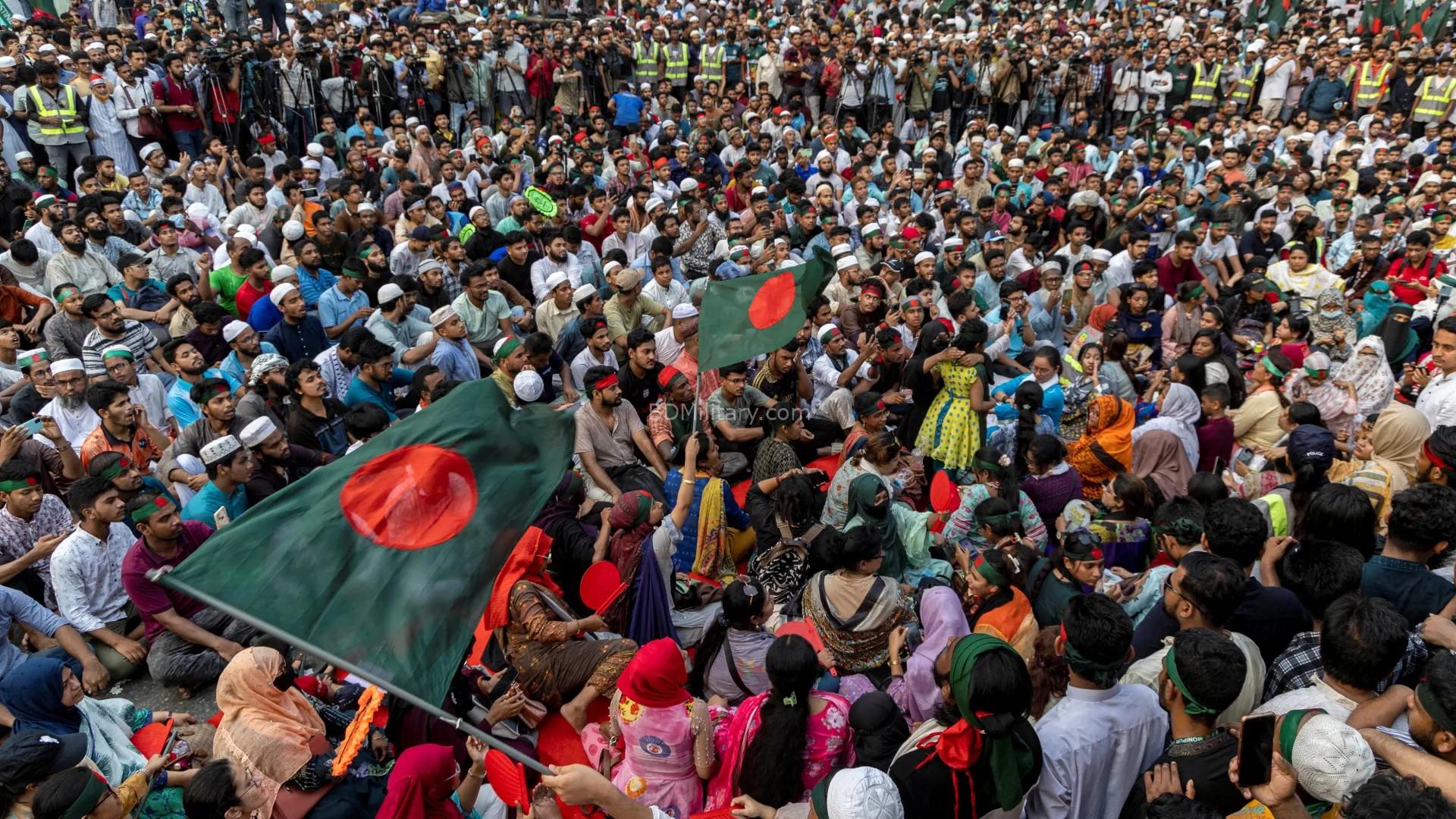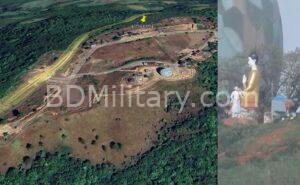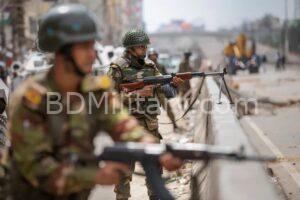Between 16 July and 5 August 2024, Bangladesh experienced one of the most profound political upheavals in its modern history, now widely referred to as the Monsoon Revolution. What began as student-led protests demanding reforms in government job quotas quickly escalated into a nationwide uprising against entrenched corruption, authoritarian governance, and economic mismanagement. Initially concentrated around university districts in Dhaka, the movement rapidly spread to Chattogram, Sylhet, Rajshahi, Khulna, and Barishal, capturing the imagination of the nation’s youth and civil society while paralysing administrative structures. By the end of July, the protests had effectively destabilised local governance, overwhelmed law enforcement, and exposed the fragility of Bangladesh’s security apparatus.
The Escalation: July 16–27, 2024
The government’s response to the demonstrations was immediate and brutal. Security forces—including the Rapid Action Battalion, Bangladesh Police, and paramilitary units—employed live ammunition, armoured vehicles, and indiscriminate crowd-control measures to suppress protestors. Human rights organisations documented over 1,400 fatalities, including more than 100 children, alongside tens of thousands of injuries. Hospitals and clinics were overwhelmed, and morgues were unable to cope with the volume of casualties, marking the episode as one of the bloodiest in the country’s post-independence history.
During the initial three days of unrest, live fire at Dhaka University resulted in at least 35 deaths and hundreds of injuries, sparking outrage that quickly amplified the protests nationwide. Between 19 and 23 July, the unrest reached Chattogram and Sylhet, where demonstrators blocked major highways, bridges, and public institutions. Security forces responded with excessive force, including night raids in residential areas, which in Sylhet reportedly resulted in over 120 deaths, many of whom were civilians caught in their homes. By 24–27 July, Rajshahi and Khulna became hotspots, as students, workers, and political activists joined forces. Attacks on government facilities prompted retaliatory crackdowns, and fatalities exceeded 500 by 27 July alone.
Dhaka Clashes and Law Enforcement Breakdown
Dhaka, the epicentre of the unrest, experienced sustained clashes between protestors and security forces from 28 July to 2 August, with curfews, internet shutdowns, and mass arrests failing to restore order. In the midst of escalating violence, several Awami League leaders fled to India, fearing backlash from protestors and legal authorities. The city became a microcosm of the nationwide crisis, highlighting both the limitations of state power and the resilience of popular mobilisation.
Sheikh Hasina’s Flight and Kolkata Exile Operations
On 5 August 2024, Sheikh Hasina officially fled to India amid mounting political pressure and the collapse of her government. Following her departure, senior Awami League figures established a covert operational hub in Kolkata, reportedly operating from a commercial office complex. This base coordinated communications, political strategy, and lobbying activities aimed at sustaining the party’s organisational structure despite its loss of domestic authority.
BDMilitary assesses that this exile strategy reflects both desperation and long-term planning: while it allows the Awami League to maintain a skeleton operational network, its effectiveness is severely limited by the loss of legitimacy and popular support on the ground. Without Sheikh Hasina’s personal authority, the Awami League is likely to fragment, and the party may wither away entirely following her eventual demise, whether by natural causes or otherwise.
Interim Government and Legal Accountability
In the immediate aftermath of Hasina’s departure, a caretaker administration was installed under Nobel laureate Professor Muhammad Yunus, tasked with restoring governance, stabilising the country, and prosecuting crimes committed during the Monsoon Revolution. On 17 October 2024, the International Crimes Tribunal issued arrest warrants for Sheikh Hasina and several former ministers, charging them with crimes against humanity.
Prosecutors have reportedly requested the death penalty for Hasina, while at least 25 senior military and law enforcement officials have been indicted for human rights violations. BDMilitary notes that this legal framework serves a dual purpose: establishing accountability for atrocities committed during the uprising and legitimising the interim government’s authority domestically and internationally, thereby weakening the capacity of the Awami League to influence political outcomes from Kolkata.
Security Sector Failures
The Monsoon Revolution exposed critical weaknesses in Bangladesh’s security and intelligence apparatus. Despite decades of intelligence sharing with India, security forces were unprepared for the scale and intensity of nationwide protests. The inability to anticipate or control mass civil unrest underscores systemic weaknesses in command, control, and coordination between military, paramilitary, and police units.
BDMilitary analysis emphasises that the indiscriminate use of force eroded public trust in the state, and ongoing reforms under the interim government will be essential to restore credibility, prevent the militarisation of civil dissent, and safeguard human rights.
Geopolitical Implications
The events significantly undermined India’s influence in Dhaka. By sheltering Awami League leaders in Kolkata, India risks diplomatic friction and reputational damage, while its intelligence failure to anticipate the uprising has reduced New Delhi’s strategic leverage. Meanwhile, the United States and China have signalled interest in engaging with the transitional Bangladeshi administration, offering opportunities to expand economic, defence, and political influence.
BDMilitary assesses that Bangladesh is likely to pursue an autonomous foreign policy, diversifying its international partnerships while minimising reliance on any single regional power. The revolution, coupled with the generational shift in political consciousness—where younger citizens do not identify strongly with the 1971 Liberation War—further reduces the capacity of historical political loyalties to shape national policy.
Economic and Social Impacts
The Monsoon Revolution disrupted economic activity, particularly in Dhaka and Chattogram, where prolonged strikes halted industrial and commercial operations. International investors temporarily reassessed engagement, though early measures by the interim government—including assurances of political stability and reform—mitigated some of the fallout. Socially, the widespread violence has reshaped public expectations of governance, with citizen activism and civic engagement likely to play an increasingly significant role in political discourse.
Generational change, particularly among youth, means that political loyalty is increasingly tied to governance performance, accountability, and responsiveness rather than historical narratives or party affiliation. This shift will define Bangladesh’s post-Hasina political environment.
Strategic Assessment
From a defence and strategic perspective, the Monsoon Revolution demonstrates several lessons for Bangladesh and regional actors. Internal governance is inseparable from security stability: over-reliance on personal leadership created vulnerabilities that were exposed during the uprising. Exiled political networks have limited efficacy; the Awami League’s Kolkata base enables coordination but cannot reverse the loss of domestic legitimacy. Regional intelligence cooperation has inherent limitations, as decades of collaboration between India and Bangladesh failed to anticipate the crisis. Finally, generational dynamics matter: the younger population’s disconnection from historical narratives will shape the post-Hasina political trajectory.
BDMilitary concludes that Bangladesh has entered a new era marked by domestic autonomy, reduced foreign influence, and heightened citizen activism, with profound implications for South Asian stability and regional power dynamics. The interim government faces the formidable task of consolidating authority, restoring institutional integrity, and engaging the international community to reinforce its legitimacy. Meanwhile, the Awami League, dependent on Sheikh Hasina’s charisma, faces an uncertain future and may fragment irreversibly after her eventual demise.
Concluding Remarks
The Monsoon Revolution of 2024 represents a watershed moment in Bangladesh’s history. The fall of the Awami League, the mass atrocities during civil unrest, and the establishment of a reform-oriented interim government have reshaped the nation’s political, social, and strategic landscape. The combination of youth-driven activism, generational shifts, and decisive legal and institutional reforms creates the conditions for a more autonomous and resilient Bangladesh, capable of asserting its sovereignty and rebalancing regional power dynamics.
The effectiveness of the interim government in consolidating authority, restoring public trust, and navigating the complex geopolitical environment will determine Bangladesh’s trajectory for decades to come. The Monsoon Revolution underscores the intertwined nature of governance, security, and foreign policy, demonstrating that political legitimacy and accountability remain the cornerstones of national stability.

Ayesha Farid is a regional security specialist focusing on South Asia, with over a decade of experience analysing inter-state tensions, cross-border insurgency, and regional power dynamics. She has worked with leading policy think tanks and academic institutions, offering nuanced insights into the complex security challenges shaping the subcontinent. Ayesha’s expertise spans military doctrines, border disputes, and regional cooperation frameworks, making her a vital contributor to BDMilitary’s coverage of South Asian strategic affairs. She leads the Geopolitics & Diplomacy section at BDMilitary. Ayesha holds a dual master’s degree — a Master in International Relations from the IE School of Politics, Economics & Global Affairs, Spain, and a Master of Public Policy from the Munk School of Global Affairs, University of Toronto, Canada — combining deep academic insight with practical policy expertise.



